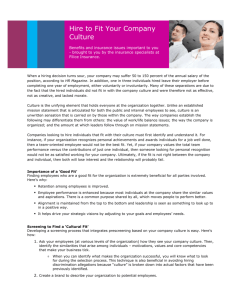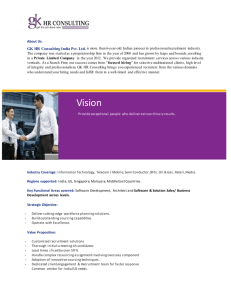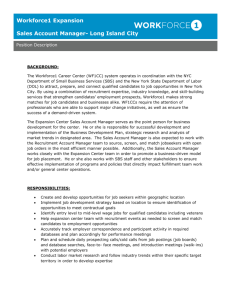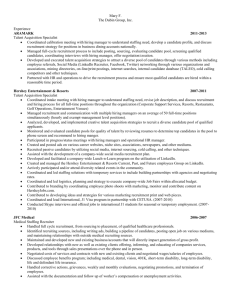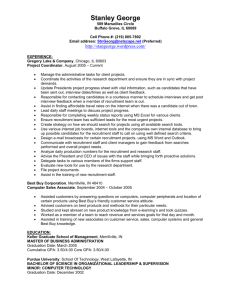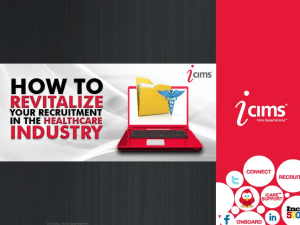Using Lean Strategies to Transform Your Recruitment Process (Deb
advertisement
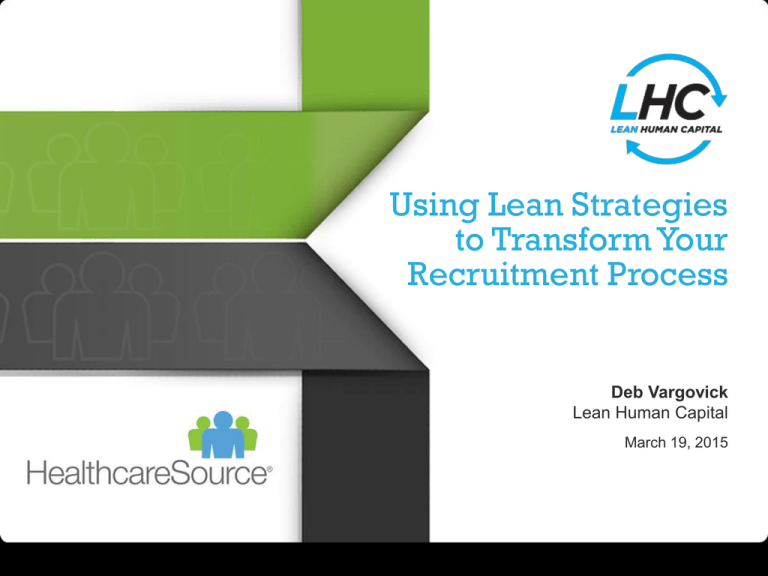
Using Lean Strategies to Transform Your Recruitment Process Deb Vargovick Lean Human Capital March 19, 2015 Presented by Lean Human Capital Sponsored by HealthcareSource ➜ Leader in healthcare talent management software partners with leader in talent acquisition training and consulting to deliver advisory, analytics and educational services LHC services now exclusively available through HealthcareSource About Deb Vargovick • A Lean, Sig Sigma certified Green Belt, • • • • Recruitment professional. Most of her career, led large, operational teams for Fortune 500 organizations such as The Walt Disney Company, The Gap, Borders Group Inc. and Best Buy . Most recently, led the Henry Ford Health System’s Talent Acquisition team through a centralization restructure and the introduction of a new sourcing model. Helped define the new organizational structure, trained 30 recruiters on new processes, and implemented a Lean program to continuously assess and eliminate waste in the recruitment process. Result: Her team cut Time-to-Fill in half within two years! © 1997-2015, Lean Human Capital, LLC. Today’s Labor Market Market Conditions Aging Population 65+ year old population will increase 50% by 20202 Sick Population 66.5% of adults in the U.S. are overweight and obese2 Decreased Supply of Healthcare Professionals The U.S. will require 10-12 million new & replacement direct care workers in 10 years1 New Population 32 million previously uninsured patients added by 20191 U.S. Population demand for Nurses will exceed supply by 1 million in 20203 Increased Demand for Healthcare Professionals By 2025, the physician shortage could be as much as 25%1 Employment in Healthcare is projected to grow 23% thru 20184 By 2020, 1 in 9 jobs in the U.S. will be in Healthcare5 ➜ When Demand for Labor Drastically Exceeds Supply, you are at Financial Risk! • Medicare Reimbursement—Not being able to hire Top Talent/quality people. • Cost of Vacancy—Related to Turnover and use of agency/OT to cover shifts and fill positions. Today’s Labor Market 34% NOT LOOKING! 14% Seriously/Actively looking 20% Casually Looking 32 % “Listeners”/ Passively looking ➜ 14% are seriously/actively seeking a new position. Top Talent: ➜ 20% are casually looking (a few hours now and then). ➜ Virtually zero unemployment rate. ➜ 32% are passively looking (if something comes along, I’ll take a look at it). We call them Listeners! ➜ If they are unemployed, they will quickly find employment. ➜ Everyone wants them. ➜ They need to be ‘recruited’ (even the top college grad’s). ➜ 34% are not looking. ➜ Source—Staffing.org, Bureau of Labor A Proactive Talent Acquisition Strategy will arguably be the most critical function within your Health Care Organization during the next decade! Topics for Discussion ➜ Define/Measure • Starts with Voice of the Customer • Baseline Performance ➜ Analyze/Improve/Control • Key Elements of Elite Recruitment Organizations ➜ Developing a Management by Fact Culture Passionate about Continuous Improvement and Lifelong learning ➜ Quantify Return on Investment What Is Lean/Six Sigma? The core idea is to maximize customer value while minimizing waste. Simply, lean means creating more value for customers with fewer resources. A lean organization understands customer value and focuses its key processes to continuously increase it. Six Sigma is about stopping defects before they happen Focus is on pleasing the customer and eliminating defects most important to the customer Decisions made based on statistical analysis of data Dramatic, breakthrough improvement Topics for Discussion ➜ Define/Measure • Starts with Voice of the Customer • Baseline Performance ➜ Analyze/Improve/Control • Key Elements of Elite Recruitment Organizations ➜ Developing a Management by Fact Culture Passionate about Continuous Improvement and Lifelong Learning ➜ Quantify Return on Investment Lean Journey starts with Voice of the Customer What do Hiring Manager and key stakeholders expect from you? Baseline Performance— Can’t Manage What You Don’t Measure VOC—“I want a cost effective recruitment solution that provides high quality candidates as quickly and efficiently as possible.” Responsiveness and Speed Cost Quality of Service Efficiency and Productivity Quality of Hire 6 Key VOC Dimensions ➜ Responsiveness and Speed ➜ Process Efficiency ➜ Quality of Hire ➜ Cost ➜ Quality Service ➜ Staff Productivity Foundation of Our Research Lean Human Capital Healthcare Community | Recruitment Metrics Benchmark Study 350+ hospitals have participated in our Recruitment Metrics Benchmark Study over the last 5 years. Community | Benchmark Study Participants: 2010 - 2015 Responsiveness Why Is Speed So Important? Reduce TTF | CDV Positions Why? ➜ Reduce Cost of Vacancy! ➜ Improve Customer Satisfaction (hiring manager, new hire, non-hired). ➜ Reduce Turnover (and cost associated with it) ➜ Patient Safety/Satisfaction ➜ Employee Morale/Engagement Story Behind the #’s Overall Healthcare Benchmark 75% < 60 Days 25 days Ave TTF 25% ≥ 60 Days 47 days Disconnect? “Perception versus Reality” Organizations underestimate time required to pipeline and source candidates for difficult to fill positions. 117 days Process Efficiency Why Is It So Important? Staffing Process Efficiency Supply Chain Management Why is a Lean Staffing Process so important? ➜ Thousands of hours are wasted on non-value added, non-revenue producing staffing activities. ➜ The time, money and resources deployed to handle ‘waste’ strangles your ability to work on value added activities like identifying qualified candidates for critical/difficult/visible (CDV) positions to reduce Cost of Vacancy and improve patient safety & satisfaction Process Efficiency Overall BM—2014 Unqualified Candidates! WASTE! NUMBER OF APPLICATIONS CANDIDATES ROUTED FOR CONSIDERATION 45,312 24 to 1 11,517 6.1 to 1 Wait Time! OFFERS HIRES 90% 2098 1,888 Reducing Cost (Wait/Waste) Process Efficiency Case Study Baseline Median BM Current 35/9.3/0.87 24/6.1/0.9 20/5/0.94 # of applications received (dispositioned) 66,080 45,312 37,760 # of candidates routed to Hiring Mgr. for consideration 17,558 11,517 9,440 # of offers extended to Candidates 2,170 2,098 2,009 Hires 1,888 1,888 1,888 Efficiency Analysis Recruiter Time Savings Compared to Low 25% # Hours Saved by Recruiters dispositioning unqualified applicants (assuming review 75% of resumes @ 2 minutes per resume). 708 Hiring Manager Time Savings # Hours Saved by Hiring Managers Reviewing Resumes (assuming 3 minutes per resume) # Hours Saved by Hiring Managers Interviewing Candidates (assuming 50% are interviewed and each interview takes 1 hour) Compared to Low 25%: Takes 5163 LESS hours to fill the same amount of positions (1888). ➜ Hiring Managers: 4465 LESS hours ➜ Recruiters: 708 LESS hours 406 4059 Cost Metrics Being Fiscally Responsible Being Fiscally Responsible Why is it important? ➜ Show how you are contributing to one of the top 3 initiatives of your health system ➜ Cost savings will allow you to invest $ in value added resources (training, sourcing tools, etc.) Story Behind the #’s ➜ Cost of Hire: ➜ Other Recommendations: • Top 25%: $496 • Calculate Cost Savings: • Mean—$991 • By improving process efficiency • Low 25%: $1123 • Reducing TTF for CDV positions ➜ Recruitment Cost Ratio: • Reducing turnover • Mean: 3.5% (compare this to RPO of search firm %) Definitions • Cost of Hire—Total Internal and External Recruitment Costs associated with sourcing, recruiting and staffing activities to fill open positions DIVIDED BY the Total Hires. • Recruitment Cost Ratio—Total Internal and External Recruitment Costs associated with sourcing, recruiting and staffing activities to fill open positions DIVIDED BY the anticipated first-year (or annualized) financial compensation offered to and accepted by new calendar year non-physician hires. Reducing Direct Costs — Turnover Case Study Lean Human Capital—Turnover Calculator Assumptions # of employees in the position Turnover % Total number of replacement employees Average annual compensation Average tax and benefit cost as % of salary (25% is average) Average loaded hourly admin labor costs Average loaded hourly HR/recruiter labor costs Average loaded hourly hiring manager labor costs Average time spent by HR manager for exit interviews Average time spent by admin for termination processing Separation pay (# of weeks offered) Average # of applications received to fill 1 position Average time spent dispositioning applicants Average # of candidates Pre-screened by Recruiting/HR Average time spent by HR Phone/Interview candidates Cost pre pre-assessment test (manpower) Average # of candidates interviewed by hiring manager to fill 1 position Average time spent by hiring manager interviewing candidates Average time spent by HR to creating/deliver/processing offers Cost per source of hire (media, posting, agency, etc.) Background check/drug/medical exam costs per hire Average candidate travel costs per hire Moving expenses Post offer onboarding admin expenses Average sign on bonus per hire # of hours spent in formal training/onboarding per new hire. Learning curve—# of months to full ramp up Lost productivity % during learning curve period Cost of 1 RN Separation Costs Total labor costs for exit interviewer's time $ Total admin labor costs for termination processing $ Total separation pay $ Total separation costs across all replaced employees $ 38 38 Recruitment Replacement Costs Total costs—source of hire $ Total labor costs to disposition all applicants $ Total labor cost for pre-screening candidates $ Total pre-assessment testing costs $ Total labor cost for hiring manager interviews $ Total labor cost for HR/recruiter to create/deliver offer $ Total recruitment replacement costs $ 750 17 165 79 284 25 1,320 Onboarding Replacement Costs Background check/drug/medical exam costs per hire $ Average candidate travel costs per hire $ Moving expenses $ Post offer onboarding admin expenses $ Average sign on bonus per hire $ Total Onboarding Costs $ 530 38 568 Total Training Costs New hire labor costs during Training/onboarding $ Total learning curve costs $ Total Training Costs $ 1,302 5,640 6,942 TOTAL TURNOVER COSTS $ 8,867 Reducing Cost — TTF Case Study ➜ LHC—Cost of Vacancy Analysis Daily Cost of Vacancy (EXAMPLE DATA) Hard Cost Producti vity Lost Overall Cost Direct Care RN—OT $274 $0 $274 Direct Care RN—Agency $219 $131 $350 Direct Care RN—PD $9 $0 $9 Blended Daily Cost of Vacancy ($274 + $350 + $9) = $211 $211 # of Direct Care RN positions filled in MORE than 60 days (2013) 240 Average TTF for positions filled in MORE than 60 days (2013) 136 Total COV (assuming vacancy) $6,887,040 Average TTF Reduced by 25% New Average TTF moving forward 102 Total COV $5,165,280 Cost Savings!!! $1,721,760 Quality of Service Are Our Customers Raving Fans? Voice of the Customer ➜ HMARTsm ➜ New Hire Experience ➜ Non-Hired Applicant Experience Dr. Jeffery Sanchez-Burks, Associate Professor from the University of Michigan Ross School of Business, and Partner at LHC, developed this statistically validated assessment survey methodology. HMARTsm Understanding 5 Communication statistically validated dimensions of customer performance Care Satisfaction Quality of Hire 1 Completely Disagree 2 Strongly Disagree 3 Somewhat Disagree 4 Neither Agree nor Disagree 5 Somewhat Agree 6 Strongly Agree 7 Completely Agree Topics for Discussion ➜ Define/Measure • Starts with Voice of the Customer • Baseline Performance ➜ Analyze/Improve/Control • Key Elements of Elite Recruitment Organizations ➜ Developing a Management by Fact Culture Passionate about Continuous Improvement and Lifelong Learning ➜ Quantify Return on Investment Key Elements of Top Performing Recruitment Organizations Insights/Observations ➜ Four Key Elements for Success: 1. Technology, Tools & Scalable, Lean Process(s) 2. Competency/Skills of the Recruitment Staff 3. Adequate # of Resources (and optimized organizational structure) to meet Hiring Demand 4. Commitment to Management by Fact/Continuous Improvement Culture While most organizations invest 75% of their time, money and resources on technology, tools and scalable processes, our research indicates the primary drivers of success are related to elements #2, #3, and #4 noted above. Technology Establishing a Strong Technical Foundation! ➜ Great companies use technology to accelerate growth, productivity, etc.. ➜ Technology itself does not make them a great organization (or recruiter). Establishing a Strong Technical Foundation! ➜ Are you using all the functionality of your ATS/HRIS systems? ➜ Is the staff accurately using systems to capture key data to measure performance? ➜ Are you leveraging technology for pre-assessment? Reference checking? Onboarding, Talent Management, etc.? Lean, Customer-Centric Process Process Improvement Value Stream Mapping to Reduce Waste and Wait Time ➜ Definition of a Value Stream Map • A value stream can be defined as all the steps—both value added and non value added—required from customer request to successful delivery of product or service. Value Stream Process Customer Request Process Process Process Customer Receipt Value Stream Mapping Total Lead Time Process Time Process Process Process Process Delay Time(s) Customer Request Total Lead Time Customer Receipt Value Stream Mapping Exercise The Goal ➜ Ask which activities within each process/step are waste and which ones truly create value. • ‘Value-Added’ Activities. • ‘Non-Value Added’ Activities. ➜ To improve process & shrink Lead Time—focus on developing solutions to remove: • ‘Non-Value Added’ Tasks. • Reduce Delay Time. Value Stream Mapping Value Stream Customer Request Customer Receipt Lean Staffing Process Case Study Baseline—Time-to-Fill Total Process Time: 5.5 hours TTF: 24 days (75% of time) TTF: 120 days (25% of time) Total Delay Time: 23-119 days Current State TTF: 17 days (83% of time) Total Process Time: 4.7 hours TTF: 98 days (17% of time) Total Delay Time: 16-97 days People Competencies and Skills of Elite Recruiters? Competency and Skills Gap Analysis Recruiter Responses Manager Responses Questions Questions Customer/Client Focus: Maintains unwavering focus on delighting the customer/client. 5.00 Self-Direction: Establishes goals, deliverables, timelines, and budgets with little or no motivation from superiors. Assembles and leads teams to achieve established goals within deadlines set. 4.00 Customer/Client Focus: Maintains unwavering focus on delighting the customer/client. 4.00 Self-Direction: Establishes goals, deliverables, timelines, and budgets with little or no motivation from superiors. Assembles and leads teams to achieve established goals within deadlines set. 4.00 Drives for Results: Exhibits strong drive for results and success. 4.00 Flexibility: Willingness to change to meet organizational needs. Adapts to stressful situations. 4.00 Drives for Results: Exhibits strong drive for results and success. 4.00 Flexibility: Willingness to change to meet organizational needs. Adapts to stressful situations. 4.00 Judgment: Makes sound decision tempered by practicality and common sense. 4.00 Urgency: Consistently responds promptly and efficiently to problems and tasks. Rarely late for meeting project deadlines and is punctual. 4.00 Judgment: Makes sound decision tempered by practicality and common sense. 4.00 Urgency: Consistently responds promptly and efficiently to problems and tasks. Rarely late for meeting project deadlines and is punctual. 3.00 Communication: Expresses oneself effectively both orally and in written form. Actively listens to others. 4.00 Influence: Convinces other to embrace a position or take a specific course of action. 4.00 Communication: Expresses oneself effectively both orally and in written form. Actively listens to others. 4.00 Influence: Convinces other to embrace a position or take a specific course of action. 3.00 Creative Problem Solving: Identifies and collects information relevant to the problem. Uses brainstorming techniques to create a variety of choices. Selects the best course of action. 4.00 Leveraging Networks: Draws upon a wide range of professional and business relationships for help and support in achieving individual and organizational goals. 4.00 Creative Problem Solving: Identifies and collects information relevant to the problem. Uses brainstorming techniques to create a variety of choices. Selects the best course of action. 4.00 Leveraging Networks: Draws upon a wide range of professional and business relationships for help and support in achieving individual and organizational goals. 2.00 Interpersonal Skills: Treats others with respect and dignity. Promotes a productive culture by valuing individuals and their contributions. 3.00 Negotiation: Skillfully uses argument and persuasion to reach a favorable position without causing hostility or hard feelings. 3.00 Interpersonal Skills: Treats others with respect and dignity. Promotes a productive culture by valuing individuals and their contributions. 5.00 Negotiation: Skillfully uses argument and persuasion to reach a favorable position without causing hostility or hard feelings. 3.00 Organization and Time Management: Is organized and plans ahead in completing work tasks. Productive, efficient and able to simultaneously juggle multiple demands and get things accomplished. 4.00 Financial: Does not waste resources. Looks for methods to improve processes that have a positive impact on the bottom line. 4.00 Organization and Time Management: Is organized and plans ahead in completing work tasks. Productive, efficient and able to simultaneously juggle multiple demands and get things accomplished. 3.00 Financial: Does not waste resources. Looks for methods to improve processes that have a positive impact on the bottom line. 3.00 Business Acumen: Understands how the lines of business supported develop strategies, services customers, and generates profits. 3.00 Attitude: Positive about work; is cooperative and follows through on commitments. Manages stress well. 4.00 Business Acumen: Understands how the lines of business supported develop strategies, services customers, and generates profits. 3.00 Attitude: Positive about work; is cooperative and follows through on commitments. Manages stress well. 4.00 Evaluating Candidates: Evaluates, selects and hires top talent by objectively comparing a candidate's qualifications to identified business needs, job specifications, and competencies. 3.00 Professionalism: Sets examples. Stays current in terms of professional development. 4.00 Evaluating Candidates: Evaluates, selects and hires top talent by objectively comparing a candidate's qualifications to identified business needs, job specifications, and competencies. 3.00 Professionalism: Sets examples. Stays current in terms of professional development. 4.00 Staffing Lifecycle Management: Plans and successfully executes a recruiting, selection and hiring process that results in top talent for the organization. 4.00 Idea Generation and Innovation: Embodies creativity and innovation in identifying talent through multiple sources; networking, on-line, in person, job fairs, advertisements, etc. 4.00 Staffing Lifecycle Management: Plans and successfully executes a recruiting, selection and hiring process that results in top talent for the organization. 2.00 Idea Generation and Innovation: Embodies creativity and innovation in identifying talent through multiple sources; networking, on-line, in person, job fairs, advertisements, etc. 2.00 Builds Appropriate Relationships: Develops strong interpersonal alliances at appropriate levels, both within and outside the organization; builds solid relationships characterized by mutual respect 4.00 Sales Orientation: Ability to be the face of the organization for recruitment—Providing candidates with information highlighting the organization as an employer service. 4.00 Builds Appropriate Relationships: Develops strong interpersonal alliances at appropriate levels, both within and outside the organization; builds solid relationships characterized by mutual respect 4.00 Sales Orientation: Ability to be the face of the organization for recruitment - Providing candidates with information highlighting the organization as an employer service. 3.00 Teamwork: Uses appropriate interpersonal style to steer members towards the goal. Organizes resources to accomplish tasks with maximum efficiency. 4.00 Teamwork: Uses appropriate interpersonal style to steer members towards the goal. Organizes resources to accomplish tasks with maximum efficiency. 4.00 Overall Ratings 3.43 Overall Ratings 3.96 Right Person in the Right Seat on the BUS! Right Person Right Seat Your BUS! - Jim Collins—Good to Great Defining the Resources Required to Meet Hiring Demand Demand-Based (MRP) Resource Allocation Methodology Case Study Staffing Optimization Model Recruitment Resource Planning/Allocation Total # of Hires # of Sourcing/Pre-qualification Hours Required # of Recruitment Process Hours Required Total Recruitment & Resource Process Hours # of FTE Recruiters Required to Meet Hiring Objectives # of Interview/Hire Process Hours Required by Admin BAU CDV 2,440 12,200 3,796 15,996 10.4 5,733 815 8,150 1,721 9,871 6.4 1,915 4 1.2 # of FTE Admins Personnel Required to Meet Hiring Objectives Current Leaders Recruiters Administrative Total FTE AA Recommended (based on Staffing Optimization Methodology) AA 0.5 7.5 1.5 9.5 Totals 3,255 20,350 5,516 25,866 17 5.0 Livonia 0.0 0.8 0 0.8 Oakland 0.0 3.4 0 3.4 Chelsea 0.0 0.5 0.7 1.2 Overall 0.5 10.7 2.2 14.9 Livonia Oakland Chelsea Overall Leaders 1.0 0.3 0.3 0.3 2.0 Recruiters 9.0 2.5 4.5 1.0 17 2.5 12.5 0.8 3.7 1.2 6.0 0.5 1.8 5.0 24.0 -0.5 -2.5 -1.0 Livonia -0.3 -1.7 -0.8 Oakland -0.3 -1.1 -1.2 -4.0 -2.8 -2.5 Administrative Total FTE Plus/Minus - FTE Headcount Leaders Recruiters Administrative Total FTE AA © 1997-2015, Lean Human Capital, LLC. Chelsea Overall -0.3 -0.5 0.2 -1.5 -6.3 -2.8 -1.0 -10.6 Topics for Discussion ➜ Define/Measure • Starts with Voice of the Customer • Baseline Performance ➜ Analyze/Improve/Control • Key Elements of Elite Recruitment Organizations ➜ Developing a Management by Fact Culture Passionate about Continuous Improvement and Lifelong Learning ➜ Quantify Return on Investment © 1997-2015, Lean Human Capital, LLC. Management by Fact Developing a Balanced Performance Scorecard* *Based on what is important to the customer(s). © 1997-2015, Lean Human Capital, LLC. Align Recruitment Scorecard with Organizations Strategic Objectives Health System HCAHPS Recruitment Voice of Customer (Hiring Manager, New Hire, Non-hired) Clinical Outcomes Performance Outcomes (Speed/Efficiency/Quality/Productivity/Cost) Alignment and Presentation is Priceless ! 2013 Recruitment Scorecard—XYZ Health System Quality—Voice of Customer—Experience Hiring Manager Assessment of Recruitment Team (HMART) Overall Score Understanding Communication Care Satisfaction Quality of Hire New Hire Experience Non-Hired Candidate Experience Performance Outcomes Quality—Hire 2012 Q1—2013 Q2—2013 Q3—2013 Q4—2013 Benchmark Benchmark Benchmark Goal 6.00 6.00 6.00 6.00 6.00 6.00 Actual 5.7 6.1 5.5 6.2 6.0 5.9 Actual Actual Actual Actual 6.0 4.5 6.2 4.7 Low 25% NA NA NA NA NA NA NA NA Median NA NA NA NA NA NA NA NA Top 25% NA NA NA NA NA NA NA NA Goal Actual 12.0% 8.0% 3.3% 9.3% 1.1% Actual Actual Actual Actual Low 25% NA NA 4.9% 14.8% 4.9% Median NA NA 4.9% 14.8% 4.9% Top 25% NA NA 4.2% 11.2% 4.2% 14.8% 14.8% 11.2% Goal Actual 3.5% 2.7% 185 13.2% 61 Actual 36 7.4 88.5% 23 6.0 96.6% Actual 49 65 73% 17 27% 130 34% 43 62 78% 16 22% 136 41% Actual $577 Actual Actual Actual Actual Actual Actual Actual Actual Actual Actual Actual Actual Actual Actual Actual Actual Low 25% 5.9% 7.6% 160 9% 55 Low 25% 50 7.5 88.5% 26 5.4 79.6% Low 25% 60 77 67% 28 33% 129 42% 56 72 65% 29 35% 135 47% Low 25% $715 Median 4.0% 4.4% 191 14% 40 Median 33 6.6 92.0% 21 4.0 91.8% Median 53 67 71% 25 29% 122 34% 51 67 72% 25 28% 111 37% Median $ 665 Top 25% 3.4% 3.1% 239 27% 25 Top 25% 18 4.7 93.5% 14 2.4 93.9% Top 25% 47 62 73% 23 27% 106 31% 44 60 77% 22 23% 98 24% Top 25% $ 576 Annual Turnover Rate—Overall Annual Turnover Rate—RN's Average 90 Day Separation/Turnover Rate—Overall Average First Year of Service Turnover Rate—Overall Average 90 Day Separation/Turnover Rate—RN's Average First Year of Service Turnover Rate—RN,s Productivity 4.7% Overall Vacancy Rate Direct Care RN Vacancy Rate Staff Productivity (XX FTE) Employee Referral % Average Req's Per Recruitment Resource Delivery—Efficiency Applicants to Positions Filled Ratio Applicants Routed to Positions Filled Ratio Percentage of Positions Filled from Extended Offers RN Applicants to Positions Filled Ratio RN Applicants Routed to Positions Filled Ratio Percentage of RN Positions Filled from Extended Offers Delivery—Responsiveness Average Time-to-Fill—Overall Average Time-to-Start—Overall % of Positions Filled in LESS Than 60 Days Average TTF for Positions Filled in LESS Than 60 Days % of Positions Filled in 60 Days or MORE Average TTF for Positions Filled in 60 Days or MORE % of Current Positions Currently Open over 60 Days Average Time-to-Fill—RN's Average Time-to-Fill—RN's RN—% of Positions Filled in LESS Than 60 Days RN—Average TTF for Positions Filled in LESS Than 60 Days RN—% of Positions Filled in 60 Days or MORE RN—Average TTF for Positions Filled in 60 Days or MORE % of Current RN Positions Currently Open over 60 Days Cost Cost Per Hire Goal Goal Goal Performance Management To migrate to a Management by Fact Culture passionate about Continuous Improvement and to ensure you have the right people in the right chairs, we recommend: • Develop and maintain quarterly scorecards for overall team, site and individual recruiters/sourcers. • Review 90 day/First Year Turnover and Extended Offers that are declined/rejected/rescinded quarterly. • Develop and utilize Aging Reports bi-weekly to manage requisitions and proactively manage workload. • Utilize this data on quarterly basis to: • Celebrate Success (against goal). • Develop/implement performance improvement solutions. • Quantify ROI to key stakeholders (COV, process efficiency, quality of hire, customer satisfaction, etc.). ➜ It is very difficult to identify if your staff has the right competencies and skills to perform their job if you do NOT have individual performance metrics to evaluate performance. ➜ Critical to the success of your recruitment team is their coach/mentor who can use data/fact to show them HOW to improve, not preach WHAT they need to do. Management by Data/Fact Case Study ➜ Organization that has been on a Recruitment Transformation Journey for the last 18 months. ➜ FY2014 Annual Review to CHRO and key executives ➜ Share how they performed: • Interesting Observations/Analysis • Celebrate Achievements • Opportunities for Improvements Management by Data/Fact Case Study FY14 Performance Outcomes Delivery—Responsiveness Average Time-to-Fill—Overall % of Positions Filled in LESS Than 60 Days Average TTF for Positions Filled in LESS Than 60 Days % of Positions Filled in 60 Days or MORE Average TTF for Positions Filled in 60 Days or MORE % of Current Positions Currently Open over 60 Days Goal Q1 Actual Actual 62 63% 26 37% 124 Q2 Actual 67 60% 26 40% 128 Q3 Actual 73 57% 24 43% 137 Q4 Actual 71 60% 26 40% 139 Benchmark Average FY 14 68 60% 25 40% 132 Interesting Observations/Analysis: Low 25% 55 65% 25 35% 123 30% Benchmark Benchmark Median 51 72% 24 28% 118 25% Top 25% 39 77% 22 23% 113 18% G- Good/Great Y- Average/Adequate NA- Needs Attention ➜ Average Time-to-Fill Overall = Average/Adequate with an average of 68 • While the average TTF is not within benchmark, we focused on closing positions opened greater than 200 days. • Out of 1717 positions filled in FY14, 94(18%) of the positions were opened over 200 days thus effecting the TTF average. • Top closed difficult CDVs positions: ANM’s (7), Case Managers (6), CNIII(11), CNIV(6), Career Floats(14), Pharmacist(3), Wound Care Nurse(1), PA’s(2), Speech Pathologist (1) • Union jobs remain open until position is filled, impacting the TTF. ➜ % of Positions Filled in LESS than 60 Days = Average/Adequate with an average of 60% • Although the % of positions filled in less than 60 days is not at the desired benchmark, it was because we focused on filling the backlog of aging requisition. We are confident this will dramatically improve in FY2015. Management by Data/Fact Case Study Goal: Time to Fill should be BELOW ↓ median benchmark of 53 Days. Goal: % of Reqs Filled ≤ 60 Days should be ABOVE ↑ median benchmark of 71%. Goal: Both counts should be BELOW ↓ median benchmarks. Successes: • TTF, From FY 13 and FY 14, we filled 160 more positions. • The average TTF from FY13 (69) to FY14 (68) remained flat despite an increase in the number of positions by 160 with same staff + focus on filling positions open over 60 days. • The efforts from FY13/FY14 have resulted in FY15 having a 25% average reduction in TTF (54). • Concentrated efforts on filling evergreen positions/CDV’s, impacted the number of positions filled over 60 days. • Those efforts are seen in FY15 with an approximate 7% reduction in reqs. filled more than 60 days . • Efforts for FY13/FY14, short term effect may appear negative but the long term benefit of our efforts have been out weighed thus far, in FY15. • The # of routed applicants per filled reqs. remains consistent or slightly below bench for FY13/FY14 and going into FY15. • We are now seeing the positive results of our “growing pains” of FY13/FY14 going into FY15 in all categories. Opportunities: • Continue to review “Value-Added” activities & “Non Value Added” activities for continued process improvement and productivity. • Continue to educate our clients on LEAN process. • Incorporate HMART survey results in our LEAN process to better enhance communication, quality of hires, understanding of our job requirement, etc. with our clients. • Incorporate Newly Hired survey results in our LEAN process to improve communication with our applicants/candidates. • Move forward with obtaining Exit Interview information. Quantifying ROI Results to Date! Case Study Quality of Hire 90 Day Turnover—FT/PT 9.00% 8.00% 7.00% 6.00% 5.00% 4.00% 3.00% 2.00% 1.00% 0.00% (as rated by Hiring Managers) 7.70% 7 6.6 6.2 5.3 6 Target (6.0) 5 4.2% 4 3.0% 3 2 1 0 2012 2013 2012 2014 2013 Hiring Manager Satisfaction—HMART (7pt. Scale) 7 6 6.2 6.5 6.2 6.4 5.9 5.3 6.1 6.3 5.9 5.4 6.3 6.5 5.7 6.3 6 6.6 5.9 5.4 5.1 5 4 3 2 1 0 Overall Understanding Communication 2012 2013 2014 Care Benchmark © 1997-2015, Lean Human Capital, LLC. Satisfaction 2014 Results to Date! Case Study RN—TTF Overall Time To Fill 54 53 52 51 50 49 48 47 46 45 44 60 53 50 49 49 40 Target (44) 40 50 30 47 47 20 10 Target (45) 0 2011 2012 2013 2012 2014 Position Filled 2013 2014 Staff Productivity (external and internal candidates) 3000 2500 2639 2834 250 206 202 200 2064 Target (175) 159 2000 150 1500 100 1000 50 500 0 0 2012 2013 2014 © 1997-2015, Lean Human Capital, LLC. 2012 2013 204 Transformation Journey - Commitment to Continuous Improvement! “A continuous improvement process never stops. It wasn’t implemented just once. It’s constant improvement, constant innovation and constant elimination of extra steps. The most important principle is that this is not a four-month project. You will see benefits, but you must do it continually.” Source: http://knowledge.wharton.upenn.edu Topics for Discussion ➜ Define/Measure • Starts with Voice of the Customer • Baseline Performance ➜ Analyze/Improve/Control • Key Elements of Elite Recruitment Organizations ➜ Developing a Management by Fact Culture Passionate about Continuous Improvement and Lifelong learning ➜ Quantify Return on Investment Questions? To receive a copy of this presentation, please send an email to student@leanhumancapital.com; or call Deb Vargovick at 248-918-8799
